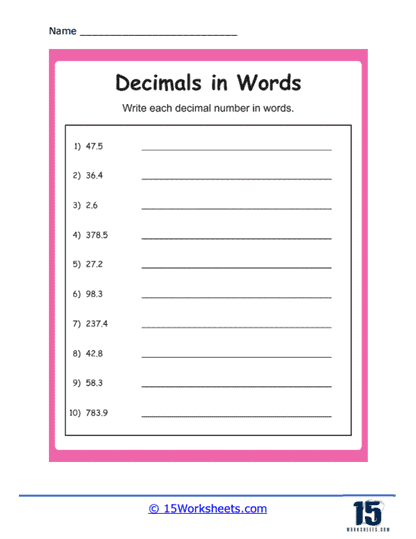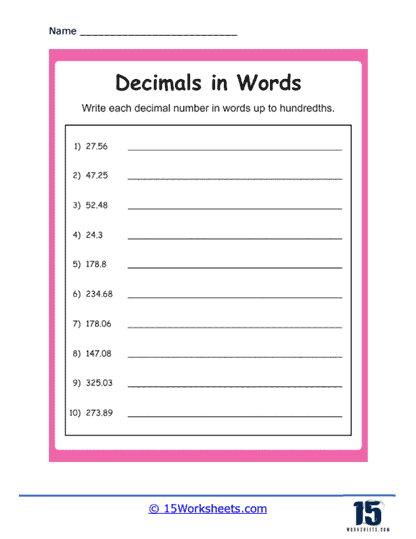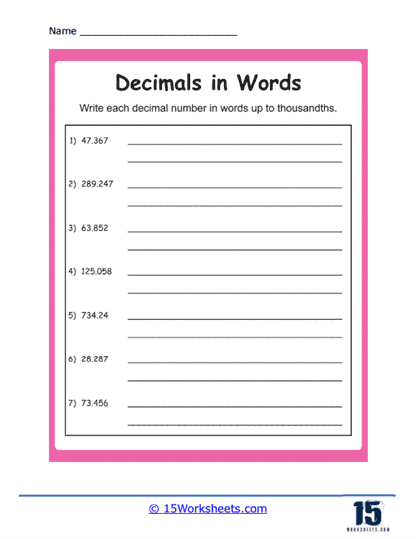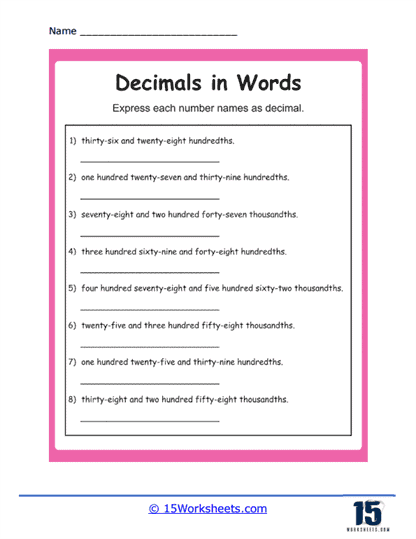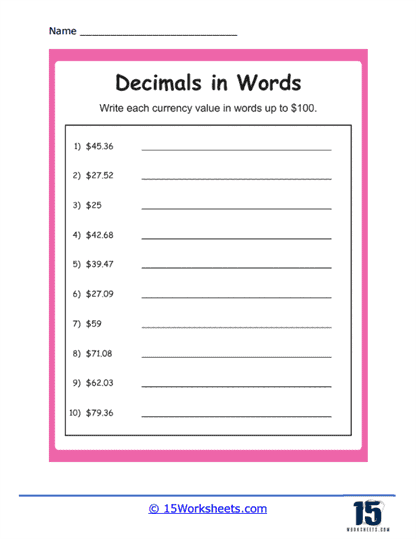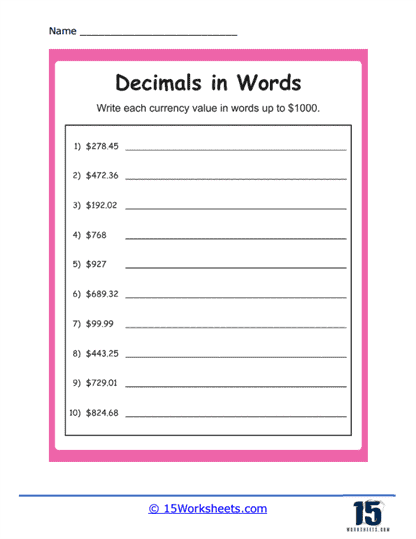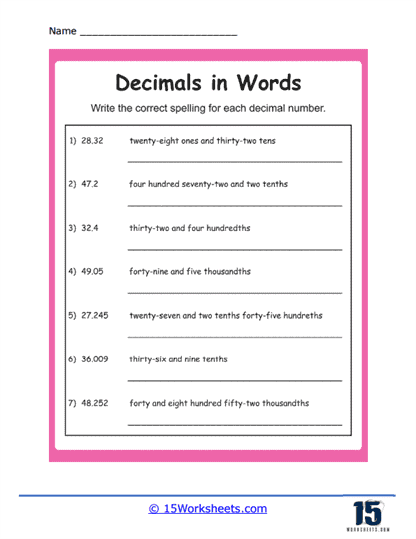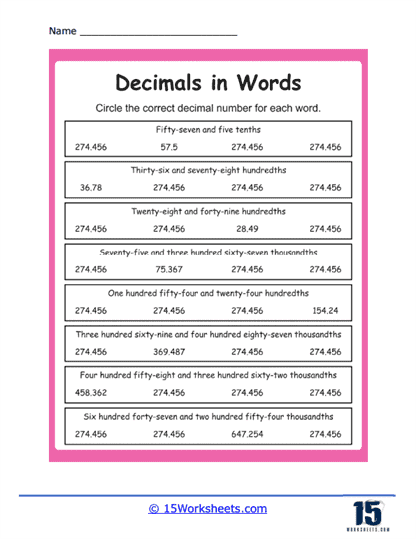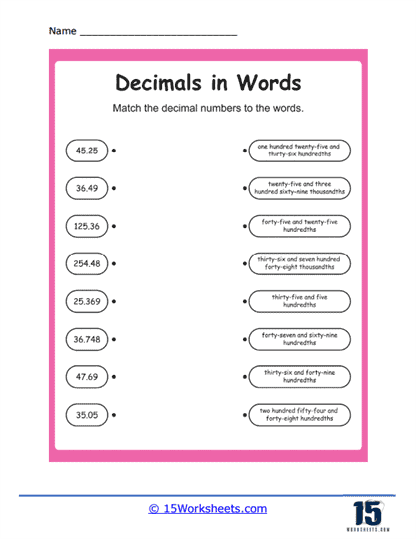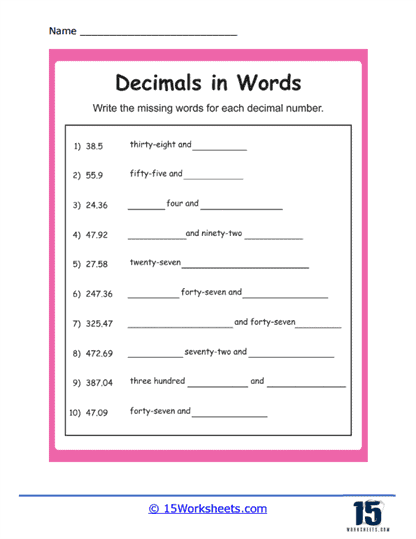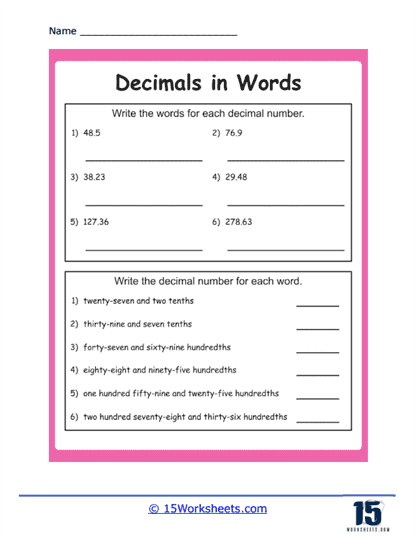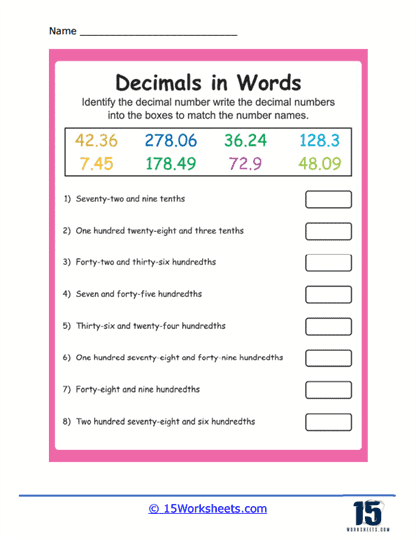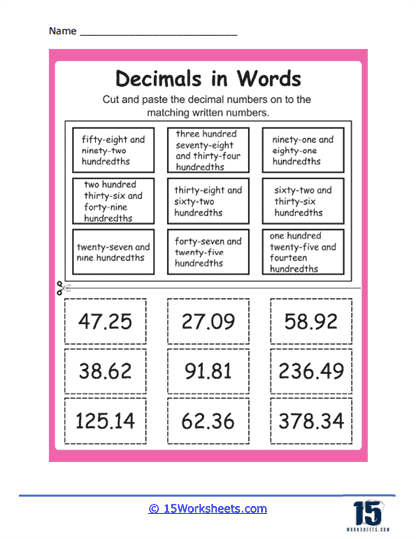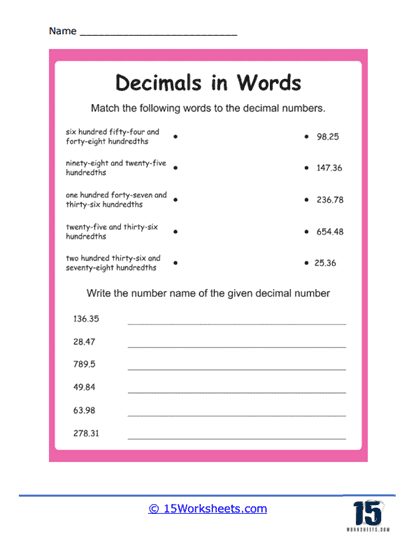Decimals in Words Worksheets
About These 15 Worksheets
Mastering the skill of expressing decimal numbers in written form is more than just an academic exercise-it is a foundational element in building a student’s overall mathematical literacy. When students can fluidly translate between numerical and word forms of decimals, they not only enhance their grasp of mathematical concepts but also improve their ability to communicate these concepts effectively. This ability is not confined to the classroom; it has practical applications in daily life and professional settings alike, making it a crucial skill for lifelong success.
The worksheets designed to teach this skill are a comprehensive tool aimed at gradually developing a student’s proficiency in expressing decimal numbers in words and vice versa. Through varied and thoughtfully structured exercises, these worksheets ensure that students build confidence and accuracy in working with decimals. But more than that, they guide students to a deeper understanding of place value, number sense, and the real-world relevance of decimals.
A Variety of Exercises
The worksheets feature a wide range of exercises to ensure students not only grasp the mechanics of translating decimals but also appreciate the reasoning behind the process. Here’s a breakdown of some key exercises:
1. Translating Numerals into Words – This exercise forms the bedrock of understanding decimals. Students are asked to convert numeric decimal values into their word form, reinforcing their understanding of place value. For example, a student might encounter a number like “0.25” and be tasked with writing it out as “twenty-five hundredths.” While this might seem simple, the value of this exercise lies in its ability to demystify decimal place values, helping students recognize what each digit represents beyond the decimal point. This precision strengthens their overall number sense.
2. Translating Words into Numerals – The reverse of the previous exercise, this task requires students to convert decimals written in words back into their numerical form. For instance, a student might be presented with “seven and twenty-six hundredths” and asked to write “7.26.” This exercise reinforces the idea that decimals are simply another way to express fractions or parts of a whole, solidifying their ability to switch seamlessly between formats-a skill essential for higher-level math.
3. Fill-in-the-Blank Exercises – These exercises are an engaging way to encourage students to think critically about decimals. A sentence might be missing a decimal value, and students are asked to fill it in, either in numeric or written form. This encourages not only recall but also application, as students must determine the appropriate form of the decimal that completes the sentence. This type of task deepens their understanding by asking them to apply their knowledge in a more open-ended format.
4. Multiple Choice Questions – Multiple choice questions add an element of strategic thinking to the learning process. Students are presented with a decimal number and several written options, or vice versa. Their task is to select the correct match. This helps hone their decision-making skills, as they must carefully weigh each option and ensure their choice accurately represents the decimal given. These questions are excellent for reinforcing attention to detail, as even small differences in wording or digit placement can change the entire meaning of a decimal.
5. Word Problems – Arguably the most engaging and practical type of exercise, word problems present real-life scenarios where decimals must be interpreted and written in word form, or where students are required to express a given decimal in both numeric and written formats. These problems bridge the gap between abstract math and the real world, encouraging students to see decimals as not just numbers on a page but as values with real-life significance. Whether calculating prices, reading measurements, or balancing budgets, these exercises bring decimals to life.
Why These Exercises Matter
Each of these activities offers unique advantages in building a student’s overall math competency. While they may seem like small steps, they collectively lay a strong foundation for a range of essential skills.
1. Mathematical Literacy – By learning how to express decimal numbers in words, students significantly improve their mathematical literacy. This doesn’t just mean knowing how to do math; it means being able to talk about it, explain it, and understand it at a conceptual level. Whether participating in class discussions, writing math papers, or even collaborating with peers, being able to communicate mathematical ideas clearly is an invaluable skill.
2. Enhanced Number Sense – Converting decimals into words and back again strengthens a student’s number sense-an intuitive feel for numbers and how they relate to each other. Students develop a clearer understanding of place value and the relationships between numbers, which is crucial for more advanced math topics like algebra and calculus.
3. Precision and Attention to Detail – When translating between numbers and words, accuracy is paramount. Students are required to pay close attention to every digit and every term, building an important habit of precision. This attention to detail is not just important in math but also in many aspects of academic and professional life.
4. Problem Solving – Word problems and multiple-choice questions push students to apply their knowledge in new and creative ways. They learn to problem-solve, think critically, and approach challenges from different angles. These are skills that extend far beyond math, contributing to a student’s overall cognitive development.
Why This Matters Beyond the Classroom
While the ability to express decimal numbers in written form is critical for academic success, its relevance extends far beyond the classroom walls. In everyday life, situations regularly arise that require this skill. For instance, when writing a check, the amount must be written in both numbers and words, and even a small mistake can cause confusion or errors. Similarly, in financial reports, contracts, or business presentations, decimal values are often written in words to ensure clarity and prevent misunderstandings.
Professionals in fields ranging from engineering to economics regularly use decimals to describe measurements, financial figures, or data points. Being able to accurately express these decimals in written form can make the difference between clear communication and costly errors.
How to Write Decimals in Word Form
To write decimals in word form, you can follow these steps:
Step #1 – Identify the place value of each digit in the decimal number. Decimal numbers are written in terms of powers of 10, just like whole numbers, but with a decimal point indicating the position of the decimal.
Step #2 – Write out the whole number part of the decimal as you normally would. This is done just like writing any whole number.
Step #3 – For the decimal part, read each digit individually and state its place value. Use words like “and” to indicate the decimal point. Here’s a breakdown by place value:
Tenths: The first digit to the right of the decimal point represents tenths.
Hundredths: The second digit to the right of the decimal point represents hundredths.
Thousandths: The third digit represents thousandths, and so on.
Use hyphens to connect compound numbers (e.g., twenty-two, fifty-six).
Use the word “zero” for any zero digits.
Here are some examples:
Example #1 – Decimal: 12.34
Word form: Twelve and thirty-four hundredths
Example #2 – Decimal: 0.0072
Word form: Seven thousand two hundredths
How to Write Number Words in Decimal Form
Remember to clearly state the place value of each digit and use “point” to denote the decimal point when converting number words to decimal form.
Step #1 – To write number words in decimal form, you can follow these steps:
Step #2 – Start by writing out the whole number part of the decimal number using regular number words.
Step #3 – For the decimal part, you’ll need to state each digit individually by its place value and use words like “point” to indicate the decimal point. Here’s a breakdown by place value:
Use the word “zero” for any zero digits.
Example #1 – Number words: Twenty-three and four tenths
Decimal form: 23.4
Example #2 – Number words: Three thousand four hundred two and fifty-seven ten-thousandths
Decimal form: 3402.0057

